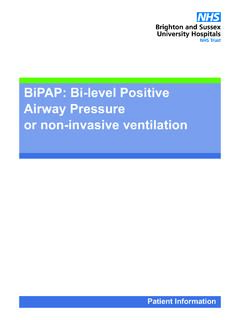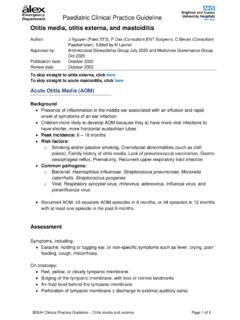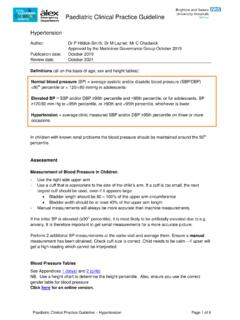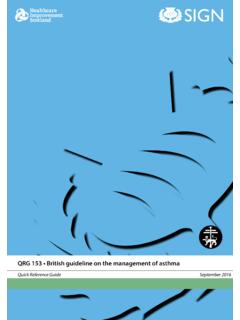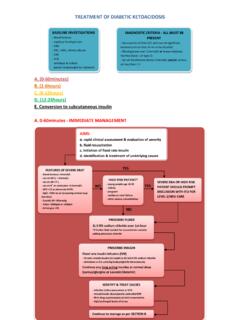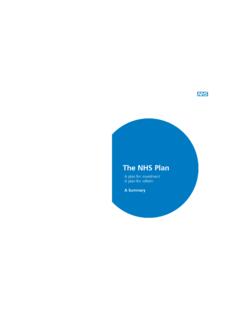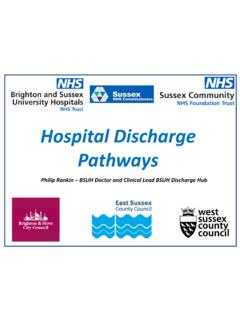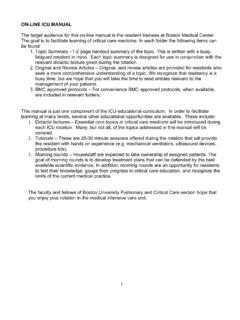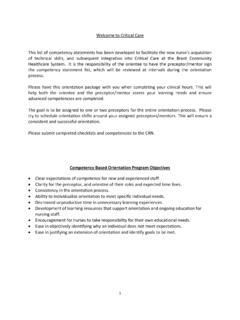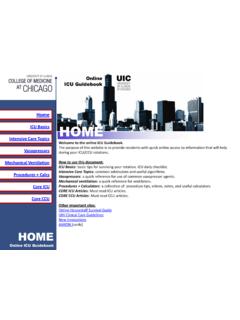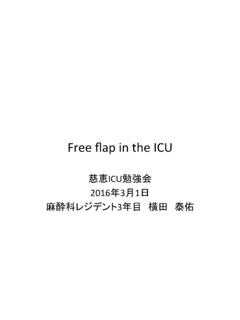Transcription of Equipment, devices and procedures in the Intensive Care Unit
1 Equipment, devices and procedures in the Intensive care unit Information for relatives, friends and carers Welcome The Intensive care unit is one of the most unnerving areas in a hospital, and it is quite normal to be anxious and worried about your visit to the ICU. Most of the patients are extremely sick and need constant, close monitoring and support from the staff, equipment and medication to keep normal body functions going. This booklet will help provide you with information regarding the need for monitoring devices , the common procedures and the treatments that we offer.
2 If it does not cover everything you need to know, our staff will be glad to answer any questions you may have. Patient information and advice can also be found on our website at and (patients and relatives section). Contents Staff and patient comfort 3. Noises and alarms 3. Equipment 4. Lines 6. Breathing tubes 7. Feeding in Intensive care 9. Urinary catheter 11. Scans: CT and MRI 12. Ultrasound 13. Echocardiogram 14. Facilities for relatives and friends 15. 2. Staff in Intensive care Intensive care units in the United Kingdom are run and staffed by specialists trained in Intensive care .
3 Once a patient is admitted to the unit the Intensive care team will manage the care of the patient in consultation with the original team that admitted the patient to the hospital and any other specialists that they think can help to aid the patient's recovery. The Intensive care doctors and nurses will give the best overview and general update on the patient, but they may refer relatives to the specialist teams for discussion of certain aspects of care . Patient comfort Patients need to be sedated to tolerate the help they need with their breathing.
4 This level of sedation is much less than is needed for an operation and patients are often partially awake. The nurses and doctors will keep reassuring the patient and make sure that they have plenty of pain relief to minimise any uncomfortable procedures that need to be done. Relatives often want to know if they can talk to the patient or touch them and this is usually encouraged. Reassuring voices and contact can really help patients. Noises and alarms Noise levels are likely to be higher than on a general hospital ward largely because of the operation of the equipment, often beeping or sounding an alarm.
5 If you do hear an alarm it doesn't necessarily mean something's wrong, just that there's something the staff need to be aware of. Staff will be able to explain the equipment and noises to you should you have concerns about the alarms. 3. Equipment It is common for patients to be connected to a number of different machines or devices whilst in the ICU. Breathing machines or ventilators Many patients need help with breathing and to do this they usually need to be sedated and have a breathing tube put into their windpipe or through the neck.
6 Such tubes are attached to a breathing machine known as ventilator. Modern ventilators use complex computers to enable patients to breath as much as possible for themselves with variable amounts of help from the machine. Sometimes, patients' breathing might be supported with tight fitting masks which look uncomfortable at first, but many patients get used to them very quickly and this means they don't need to be deeply sedated and don't need a tube putting into their windpipe. 4. Kidney machines Some patients' kidneys stop working due to their illness.
7 The kidneys work to filter the blood and remove waste products (and in doing so produce urine) so if they fail, it is important that the machines take over this job. To do this a special large tube is put into one of the big veins in the leg or neck. Monitors Patients in Intensive care are constantly monitored to track their condition and alert staff to changes. This monitoring routinely includes measurement of: l Heart rate and heart electrical tracing (ECG). l Oxygen levels in the blood l Blood pressure l Pressure in the veins (CVP).
8 L Urine output l Temperature l All the fluids, food and drugs. 5. 5. Lines These are plastic catheters or tubes sometimes referred to as drips'. or lines' and are inserted by the doctors and nurses into the patient's blood vessels. These lines help to give fluids and medications, are used in monitoring blood pressure, and for taking blood samples for regular investigations. Common lines inserted in ICU are: Arterial line A very thin tube is inserted into one of the patient's arteries (usually in the arm) to allow direct measurement of the blood pressure and to measure the concentration of oxygen and carbon dioxide in the blood.
9 Central line A thin tube is inserted into a big vein usually in the neck, shoulder or groin to measure the pressure, take blood samples and to give concentrated medications and fluids. Dialysis line or Vascath These line are similar to central lines and are inserted into a big vein. However there are bigger in diameter enabling to attach to a kidney machine in order to perform the job of the kidneys. PICC lines These lines are inserted in one of the veins in the upper arm and are long enough to reach the big veins close to the heart.
10 They have the advantage of having less chance of infection, thereby could be used for long duration of time. 6. 6. How are lines inserted? All lines inserted are done by doctors or nurses experienced in doing the procedure. Local anaesthetic will be injected into the site to numb the area before performing the procedure to ensure patient comfort. Sometimes a strong painkiller might be given through a venous line. All lines are inserted in the safest manner. Complications do occur although these are rare.
